|
Chianti fans may be aware that the main grape in this classic wine is Tempranillo. But Spain has another great Tempranillo growing region, Ribera del Duero, a D.O.P. (Denominación de Origen Protegida) viticulture area in Spain’s northern plateau.
The name translates to “riverbanks of the Duero [River].”
The area, a plateau ranging from 2,200 to 2,800 feet in altitude, hosts as many as 30 different soil types—though mostly limestone, chalk, and sand, all of which contribute to the distinctive nature of Tempranillo, the region’s dominant grape.
On International Tempranillo Day, the second Thursday in November, how about trying a bottle or two? Some connoisseurs argue that Ribera del Duero makes the world’s finest expression of Tempranillo.
Tempranillo wines from Ribera del Duero are medium- to full-bodied reds with hints of dark fruit and spices. Here are the differences between Spain’s main Tempranillo regions:
Rioja wines deliver red cherry, pepper, and subtle cinnamon notes with ample structure (tannins).
Ribera del Duero wines are typically deeper, darker, and more brooding than Rioja, with blackberry fruit flavors and intense, gripping tannins.
Ribera del Duero wines are known for their elegance and complexity. After you get to know Tempranillo, invest in some bottles with good aging potential. These are labeled Reserva and Gran Reserva. Ask your wine store’s staff for suggestions.
Good basic bottles of Ribera del Duero Tempranillo can be found for $15, and here are Sir James Suckling’s recommendations in the $35-and-under range.
Bring some bottles for Thanksgiving and as holiday gifts for your red wine-loving friends.
> The history of Tempranillo wine is below.
> Here’s more about the wines of Ribera del Duero.
PAIRING TEMPRANILLO & FOOD
A very versatile food wine, Tempranillo pairs wonderfully with:
Aged cheeses
Dark chocolate
Hearty pasta dishes
Meats: ham, lamb, poultry (turkey, anyone?), roasted or grilled meats (including steaks), and smoked meats (ribs, tandoori chicken)
Paella
Roasted vegetables
Starchy foods, including Mexican food and Tex-Mex (tacos); potstickers and other dumplings
Traditional tapas (jamón ibérico, chorizo, and Manchego cheese, and more)
Party Idea: Have a “curated” potluck party—perhaps on “Tempranillo Tuesday.” Everyone brings a bottle of Tempranillo and a dish of tapas. You “curate” by making sure no one brings the same food.
Ideally, no one will bring the same producer and vintage of Tempranillo, either—but people can bring a Tempranillo made anywhere, and different years of the same producer are fine.
TEMPRANILLO TRIVIA
The Spanish word temprano means early. Spain’s native Tempranillo grapes got their name because the variety is ready to be harvested early in the season. Tempranillo means “little early one.”
The lighter color of Tempranillo compared to say, Cabernet Sauvignon, is due to the thinner skin of the grapes. While that could mean a more medium-bodied wine, like Pinot Noir, Tempranillo can also be full-bodied depending on how old the vintage is and how long it spent aging in oak.
Tempranillo is one of the few grape varieties whose leaves turn bright red in the fall. If you can be near a vineyard in the fall, it’s a beautiful sight (photo #6).
Tempranillo is one of the top grape varieties* blended to make Portugal’s great fortified wine, Port. In Portuguese the grape is called Tinta Roriz. Full-bodied, single-varietal Tempranillos are now appearing in Portugal’s Dão and in the Alentejo regions, where the grape is commonly labeled as Aragonez (yes, it’s confusing).
The grape has made its way to the New World: in Argentina, Australia, Chile, and South Africa in the Southern Hemisphere, and in the U.S. in California, Oregon, and Texas. The terroir of the Rogue Valley of Southern Oregon is yielding wines that can be just as rich and peppery as the Ribero del Duero wines.
There is a small amount of Tempranillo in Rioja that’s a white mutation of the red grape. Called Tempranillo Blanco, it’s used to make White Rioja. The wines yield tropical fruit flavors.
THE HISTORY OF TEMPRANILLO
The Tempranillo grape is native to the Iberian Peninsula and is the flagship variety grown in Spain and Portugal.
The cultivation in Spain of Vitis vinifera, the common ancestor of almost all grape vines in existence today, began with Phoenician settlements in the south of the Iberian Peninsula, as far back as 1100 B.C.E. [source].
Based on mosaics in Ribera del Duero that show wine-making, the practice dates back 2,600 years.
Later, according to the Roman writer Lucius Junius Moderatus Columella (40 C.E. to 70 C.E.), wines were grown all over Spain. However, there are only scattered references to the name “Tempranillo.”
In 1982, Ribera del Duero was officially granted its D.O. status (Denominación de Origen, designation of origin), which determines where the wine was produced.
Prior to then, most growers sold their grapes to co-ops that vinified them and sold the wine in bulk.
But since becoming an official D.O., the region’s Tempranillo-based wines have gained international recognition, and some very fine wines are being produced by a “new wave” of Spanish growers and vintners who showed that it was possible to produce wines of great character and quality in areas outside of the Rioja region [source].
Thanks to the acclaim, during the 1990s, Tempranillo expanded in wine production worldwide. The grape is now planted in France as well as the areas noted above, making the Tempranillo grape the third most widely planted wine grape in the world (following Cabernet and Merlot [source].
Almost 90% of production worldwide takes place in Spain.
__________________
*Along with Tinta Barroca, Tinto Cao, Touriga Franca, and Touriga Nacional.
|
|
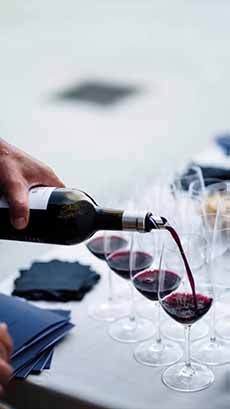
[1] Invite friends for a glass or two of Tempranillo (photos #1 through #5 © Ribera y Rueda Wine).
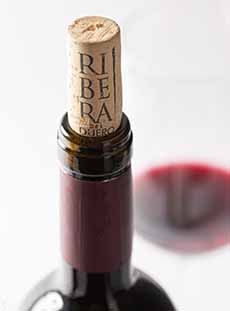
[2] Just pull the cork and enjoy.
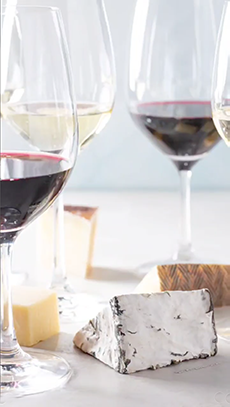
[3] Pair Tempranillo with aged cheeses.
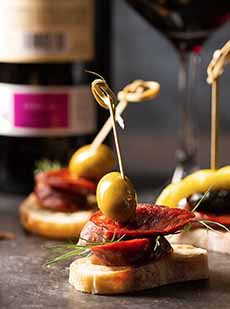
[4] Have a tapas party.
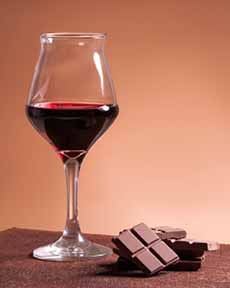
[5] If you like a glass of wine with your chocolate, consider Tempranillo (check out pairing wine with chocolate).
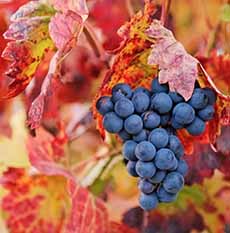
[6] A cluster of Tempranillo grapes on the vine at harvest time, when the leaves turn a brilliant scarlet (photo © Medium).
|








